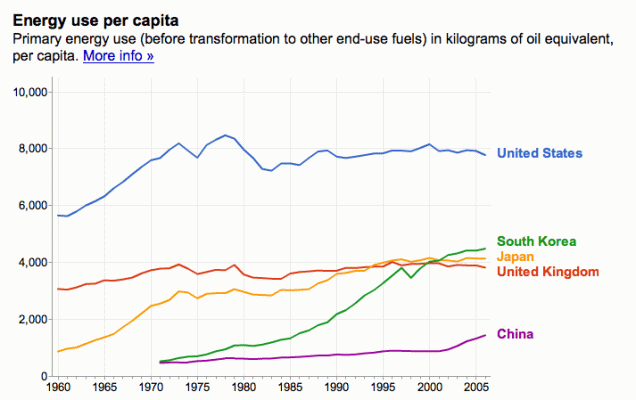ERD50
Give me a museum and I'll fill it. (Picasso) Give me a forum ...
OK, starting a new thread branched off from the one on Vehicle Safety (http://www.early-retirement.org/for...crashes-into-2009-chevy-49499.html#post922741).
IP asked this:
OK, hope you don't mind me answering a question with a question to get started. How about a plot of 'energy consumption' against CAFE standards against actual fleet mpg? Hey, you're the guy doing the cool and fancy correlation charts - maybe you could do one that normalizes that against fuel price fluctuations?
And how do we measure 'energy consumption'? Do we isolate the fuels used by fleets? If CAFE standards had spurred a lot of EVs, those would shift some of the energy from oil to coal/hydro/nukes and we would have to account for that energy. But that didn't happen to any significant degree, although I wonder if there is significant energy 'embedded' in the battery packs for hybrids (over/above the larger engine that they replace)? Could be, but I'm sure it is small enough to ignore for this little exercise.
And in a broader sense, since it merely said 'energy consumption', there is no reason to concentrate on vehicles. A gallon of oil saved in heating a home is as good as a gallon of oil saved in driving a vehicle. I'd say we should do whichever has the best ROI. But I guess we have to limit this in some way, so maybe just stick to transportation fuel for now?
-ERD50
IP asked this:
This is from the NHTSA site
CAFE | National Highway Traffic Safety Administration(NHTSA) | U.S. Department of Transportation
Corporate Average Fuel Economy (CAFE) First enacted by Congress in 1975, the purpose of CAFE is to reduce energy consumption by increasing the fuel economy of cars and light trucks.So how did it work? Was it a good government intervention or a dumb one? Some good and some bad? What have we learned from trying it?
OK, hope you don't mind me answering a question with a question to get started. How about a plot of 'energy consumption' against CAFE standards against actual fleet mpg? Hey, you're the guy doing the cool and fancy correlation charts - maybe you could do one that normalizes that against fuel price fluctuations?
And how do we measure 'energy consumption'? Do we isolate the fuels used by fleets? If CAFE standards had spurred a lot of EVs, those would shift some of the energy from oil to coal/hydro/nukes and we would have to account for that energy. But that didn't happen to any significant degree, although I wonder if there is significant energy 'embedded' in the battery packs for hybrids (over/above the larger engine that they replace)? Could be, but I'm sure it is small enough to ignore for this little exercise.
And in a broader sense, since it merely said 'energy consumption', there is no reason to concentrate on vehicles. A gallon of oil saved in heating a home is as good as a gallon of oil saved in driving a vehicle. I'd say we should do whichever has the best ROI. But I guess we have to limit this in some way, so maybe just stick to transportation fuel for now?
-ERD50


